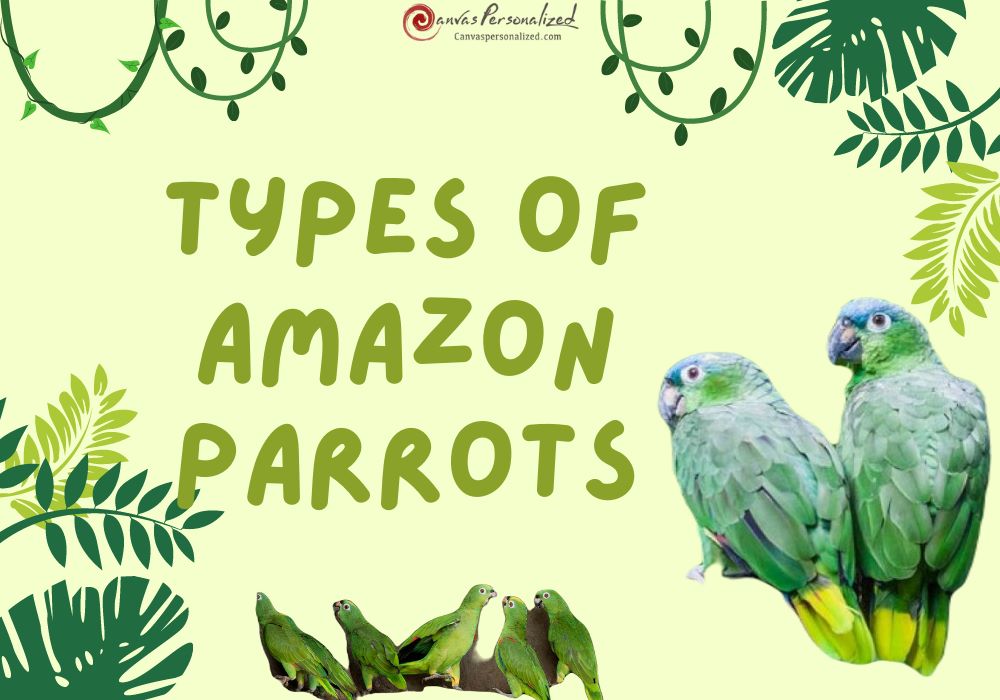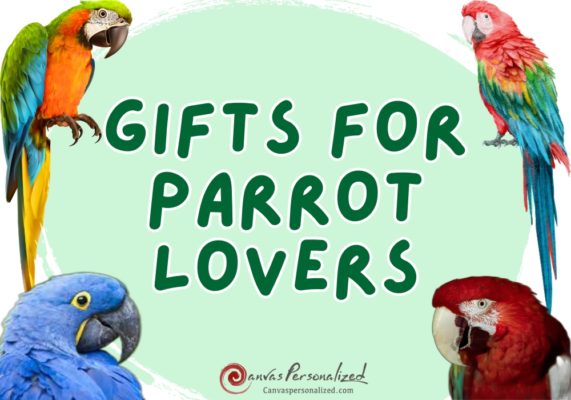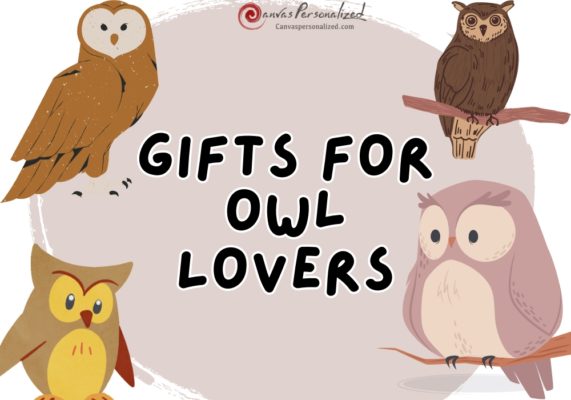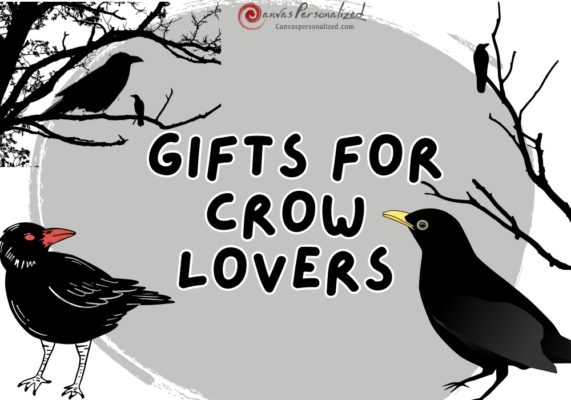Amazon parrots are naturally gorgeous birds that are also incredibly intelligent and social. These qualities make them popular bird choices for people to keep as pets. But a parrot’s one-of-a-kind character calls for an experienced bird owner. Before taking on an Amazon parrot as a primary pet, ensure you can give it the attention it needs. Canvas Personalized Blog will show 10 of the most common types of Amazon parrots kept as pets.
What Is An Amazon Parrot?
Green-plumaged, medium-sized parrots are commonly referred to as “Amazon parrots.” Their sociability, humor, and outgoing nature have made them the “center of the party.”
Furthermore, they have been known to break out into songs and play hard. Because of their sedentary lifestyles, they do not migrate or go on long journeys; they stay close to home.
10 Top Types of Amazon Parrots To Have On Your Radar
1. Red-lored Amazon Parrot
- Common names: Scarlet-lored Amazon, Red-fronted Amazon, Golden-cheeked Amazon
- Scientific name: Amazona autumnalis with three subspecies: Salvini Amazon (A.a. Salvini), diademed Amazon (Amazona autumnalis Diadema), lilacine or Ecuadorian red-lored (A.a. lilacina)
- Adult size: 12-14 inches
- Lifespan: Up to 80 years
- Average price: $1000 to $2000

These birds are striking members of the Amazon parrot family, distinguished by their dark blue feathers and bright red markings on the head, shoulders, throat, chest, and belly. Charming and social, Red-Lored Amazons form strong attachments to their human families. Some of them tend to be highly devoted to just one individual. Red-Lored Amazons can talk and sing well, but anyone who wants to own one should know that all Amazons can and do scream.
2. Blue-Fronted Amazon Parrot
- Common names: Blue-fronted Amazon parrot, turquoise-fronted Amazon parrot
- Scientific name: Amazona aestiva
- Adult size: 15 and 17 inches long, weighing between 14 and 15 ounces
- Lifespan: Can live to 80 or 100 years; most commonly, will live 40 or so years
- Average price: $1500 to $2500
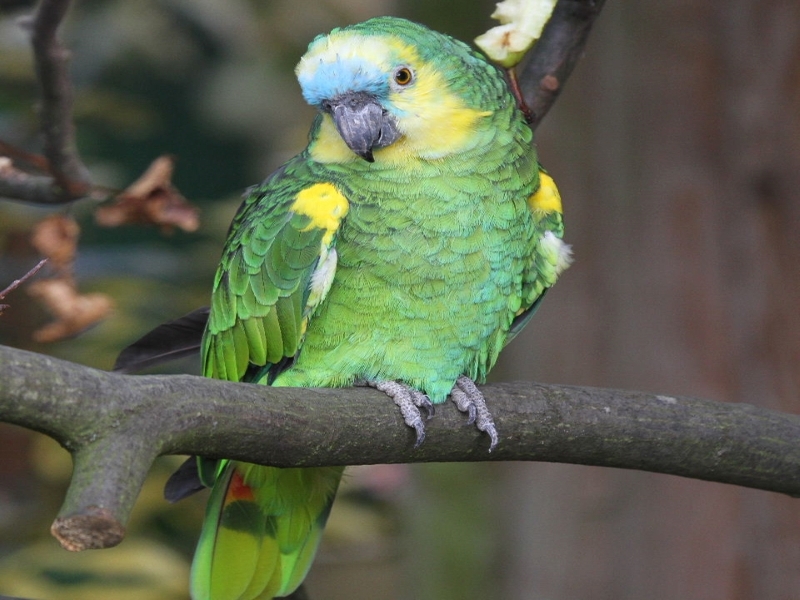
When it comes to Amazon parrots, they are among the most sought-after varieties in the Americas. Their heads are bright blue, and their backs are dark green. The Blue-Fronted Amazon is a performer at heart, and its behaviors are amusing and energetic. They adore their owners and will “ham it up” for attention. They talk and sing often, and their voices get rather loud. So, they can’t live in places like apartments where people are close together.
3. Yellow-Naped Amazon Parrot
- Common names: Yellow-naped parrot, golden-naped Amazon
- Scientific name: Amazona ochrocephala auropalliata
- Adult size: 12 to 15 inches, weighing about 1 pound
- Lifespan: 50 to 60 years or longer with the proper care; some reach the age of 70 and even 90 years old
- Average price: $1200 to $2500

Yellow-Naped Amazon parrots are beautiful birds with green feathers on most of their bodies and yellow feathers on the back of their necks. These birds, native to the Pacific coasts of Central America and northern South America, are sometimes classified as subspecies of the yellow-crowned Amazon parrot. Their primary habitats are southern Mexico and the northwest of Costa Rica.
Their friendly disposition is a big part of why so many people choose to keep them as pets. They love spending time with humans and converse a lot. The Yellow-Naped Amazon Parrot is a brilliant bird that enjoys a good challenge. Toys are essential to get the mental and physical stimulation they require. However, they might become overweight and lazy when kept in captivity, so ensure they have continual access to exercise and don’t feed them too much.
4. Lilac-crowned Amazon Parrot
- Common names: Lilac-crowned Amazon parrot, Finsch’s parrot
- Scientific name: Amazona finschi
- Adult size: On the small side for Amazon parrots, they reach about 13 inches
- Lifespan: In captivity, 60-plus years
- Average price: $1,800

Originally from Mexico’s Pacific coast, the lilac-crowned Amazon parrot is now found in other parts of the Amazon. Moist pine or oak forests up to roughly 6,000 feet in altitude are its ideal home. In honor of German naturalist and explorer Otto Finsch, this parrot is known as Finsch’s parrot. The Lilac-Crowned Amazon parrot may be distinguished from others by its purple plume covering its forehead and crown. One of the smallest Amazon parrots and much quieter than some of the larger ones. They are an excellent option for those who don’t want to wake the whole block with loud voices.
5. Double Yellow-Headed Amazon Parrot
- Common names: Double yellow-headed Amazon parrot, yellow-headed parrot, yellow-headed Amazon
- Scientific name: Amazona oratrix
- Adult size: From 14 to 16 inches, one of the larger parrot varieties
- Lifespan: 60 years old on average; some can live 80 years or more under ideal conditions
- Average price: $2,000 to $3,000
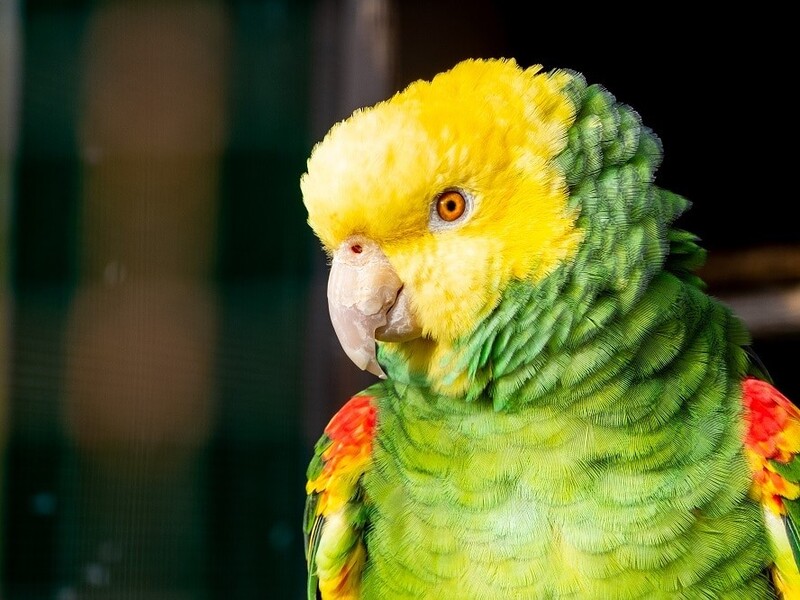
This parrot’s natural environment consists of woodlands and forests close to water. And it is native to Mexico and Central and South America. The double yellow-headed Amazon parrot’s wild population is critically threatened due to habitat degradation and capturing for the pet trade. Only a few thousand of these birds are still in their natural environment.
The International Union for the Conservation of Nature and Natural Resources lists this bird as endangered. The capturing, exporting, and ownership of wild-caught birds are prohibited under international treaties. Birds bred in captivity can be bought and sold lawfully, but you’ll need the proper paperwork.
When hand-fed and reared in captivity from a young age, Double Yellow-Headed Amazons are great, devoted pets. The Double Yellow-Headed Amazon is a fascinating bird that enjoys being the focus of attention due to its fantastic communication talents and other skills. Care, social play, and time outside the cage will take four to six hours daily. So be sure you have that much time available before adopting a pet!
6. Orange-Winged Amazon Parrot
- Common names: Orange-winged Amazon, orange-winged parrot, loro guaro
- Scientific name: Amazona amazonica
- Adult size: 13 inches long, weighing 11 to 12 ounces
- Lifespan: 60 to 70 years; some reported cases to 80
- Average price: $600 to $900

These Amazon parrots with orange wings are native to South America. Colombia, Ecuador, Peru, Trinidad and Tobago, and Venezuela are home to the most significant numbers. At the same time, small pockets of these people may be found in other countries, such as Bolivia and Brazil. Birds of this Amazon species are known for their gregarious nature. They frequently congregate with other Amazon parrots, called “flocks,” to forage for food and provide a mutual defense.
A pet Orange-Winged Amazon will be a loving member of your family. They are articulate, charismatic, and witty. At the same time, like other Amazon parrots, Orange-Winged Amazons go through a hormonal “bluffing” period as they become sexually mature. You should think long and hard about whether or not this bird (or any Amazon parrot) is suitable for you and your family because of the pinching, hissing, and lunging during this irritating period.
7. Panama Amazon Parrot
- Common names: Panama Amazon, Panama yellow-headed Amazon parrot, Yellow-fronted Amazon parrot
- Scientific name: Amazona ochrocephala panamensis, Amazona panamenisisa
- Adult size: 12 and 13 inches, weighing about 13 ounces
- Lifespan: 40 to 60 years
- Average price: $800 to $2,500
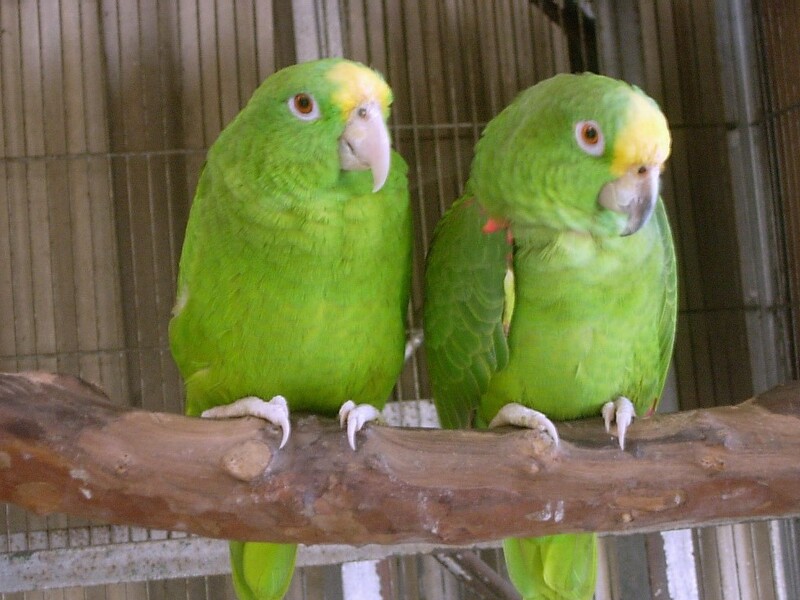
The Panama Amazon parrot, also known as the Green Amazon parrot, is sometimes misidentified as the Yellow-Naped Amazon parrot due to its similar appearance. It is a tropical bird that may be found in the wild from the Pearl Islands and Coiba in western Panama south to the northern Colombian border. Like other Amazon parrot species, its primary habitat is tropical or subtropical rainforests.
This Amazon species is rare, but you can still buy them as pets. Because they like to be around other people, they make kind and loving pets. If you talk to your Panama Amazon parrot enough, it will learn your words and, with some training, become a good talker.
8. White Fronted Amazon
- Common names: White-fronted Amazon parrot, white-browed Amazon parrot, spectacled amazon parrot
- Scientific name: Amazona albifrons subsp. albifrons; there are two other subspecies: the lesser white-fronted Amazon (Amazona alibrons subsp. nana), and the Sonora white-fronted Amazon parrot (Amazona albifrons subsp. saltuensis)
- Adult size: smaller Amazon species, white-fronted Amazons typically reach only about 10 inches in length.
- Lifespan: 50-plus years in captivity
- Average price: $1,000 to $3,000
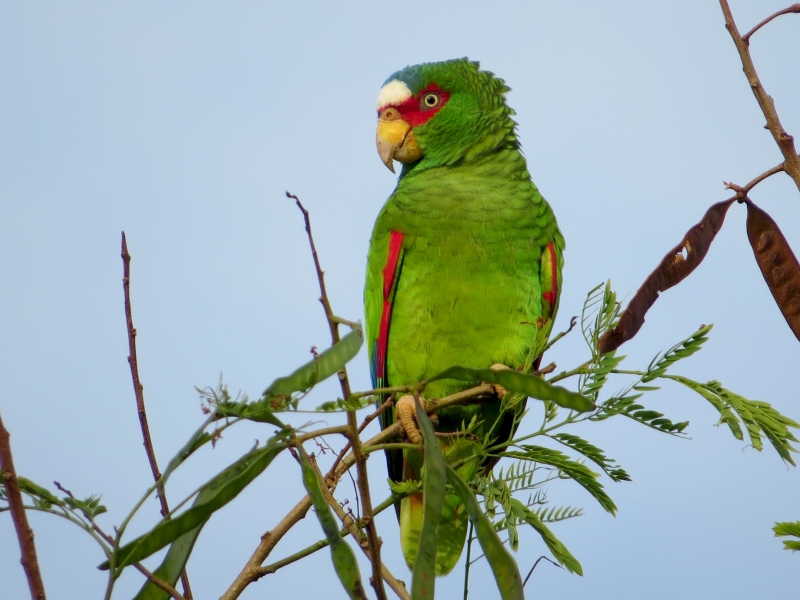
The natural range of white-fronted Amazon parrots includes Mexico and western Costa Rica, Belize, El Salvador, Guatemala, Honduras, Nicaragua, and Puerto Rico. They thrive in tropical deciduous woods and brushy grasslands. They may congregate in small groups of 20-30 individuals or prefer to be alone. Gorgeous and witty, White-fronted Amazon parrots are extraordinary pets who tend to form close relationships with one owner. Although they are the smallest of the Amazon parrots, their cries, barks, and trills may be loud.
9. Green-Cheeked Amazon
- Common names: Green-cheeked Amazon, red-crowned Amazon, Mexican red-headed parrot, red-headed Amazon
- Scientific name: Amazona viridigenalis
- Adult size: 11 to 13 inches with a wingspan of 15 to 16 inches
- Lifespan: 50 years with proper care, and sometimes as long as 70 years
- Average price: $250 to $2,000
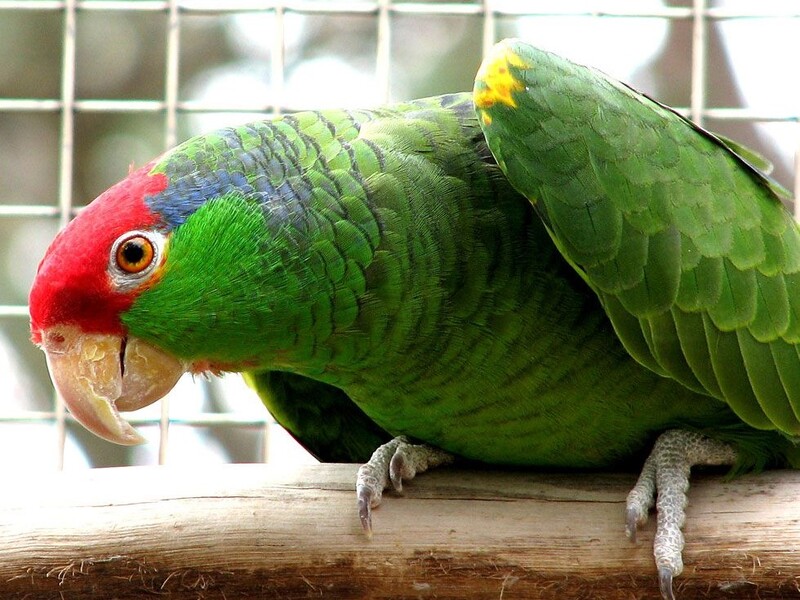
The green-cheeked amazon is native to northeastern Mexico. Lowland woods and other wooded areas are the birds’ primary habitat. The average flock is about a hundred birds, making them social creatures. A flock’s loud flying shouts make it easy to detect its presence before you see it. Playful, lovely, hand-fed play, The Green-Cheeked Amazon parrot makes a beautiful pet and thrives as part of a human family. Green-cheeked Amazons are known to be friendly birds. But some bird owners say their curiosity makes them more likely to get into trouble than other Amazon parrot species.
10. Mealy Amazon Parrot
- Common names: Mealy Amazon, mealy parrot, blue-crowned mealy parrot
- Scientific name: Amazona farinosa
- Adult size: The average length is 17 inches, and the average weight is 1–2 pounds.
- Lifespan: 60 – 70 years
- Average price: $500-$2,500
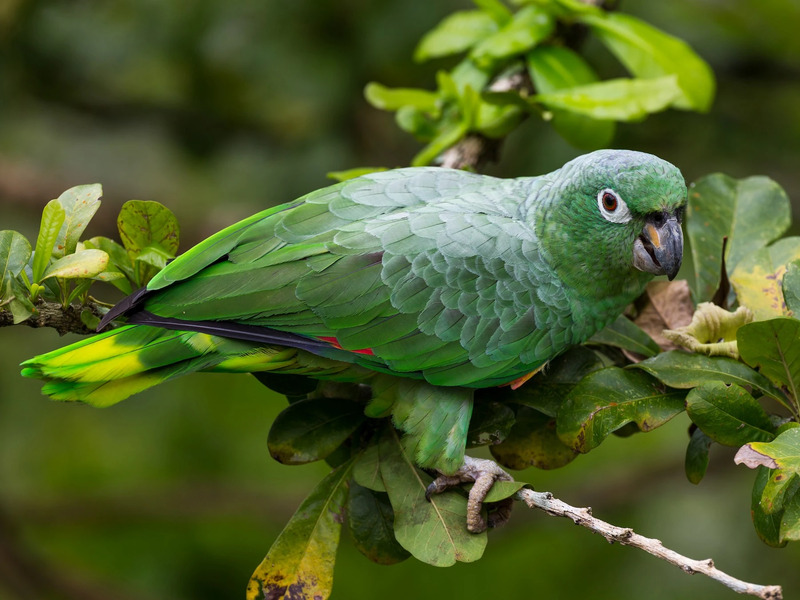
This Amazon species originated in Central and South America. Their native habitats span from southern Mexico through Bolivia, Brazil, Peru, and Colombia. The birds live in the woods and tropical rainforests of these regions. However, as farmers move closer to their habitat, they destroy fields for a more leisurely meal. Some farmers view these Southern Mealy Amazon parrots as a pest.
However, Southern Mealy Amazons are the tamest and gentle of all the Amazon parrots types. When raised as pets, they become very devoted to their bird owners. Thanks to their mild temperament, they make an excellent pet for those who desire a giant parrot but want a bird with a chiller personality.
How To Care for Amazon Parrots
Diet & Nutrition
Amazon parrots’ diets in the wild include a wide variety of seeds, nuts, fruits, berries, and plants. Every day, your Amazon parrot should be fed a pelleted bird meal and a variety of fresh fruits and vegetables. Nutritional needs change with age, size, and activity level, so talking with your vet about the amount and variety is essential.

Put a day’s worth of pellets in a dish that can’t be chewed on or tipped over, as birds like nibbling on food periodically throughout the day. After 24 hours, if any pellets remain uneaten, throw them away and replace them with the following daily serving. In a separate dish, preferably in the morning when your bird is waking up and hungry, you should feed it fresh items. Throw them out after a few hours to avoid spoiling.
Lastly, ensure your parrot has access to clean water at all times. A water dish or bottle that clips to the side of the cage can be used. Water dishes are often easier to clean than bottles since many birds prefer to bathe or dunk their food. Take your bird’s water dish away only when you’re confident it can drink from the bottle. Every day, you should replace the water.
Grooming
Most Amazon parrots enjoy getting clean. The health of the bird’s feathers may be maintained by frequent bathing. Warm water from a spray bottle or a shallow dish can be provided for your bird to play in. Some pet birds even want to join their owners in the shower. You should try to bathe your bird once or twice a week (though it may not always be interesting) and take special care that it doesn’t get its feathers too wet and then freeze.

Also, Amazon species require regular nail trimmings since their nails do not wear down naturally like in the wild. Your veterinarian will be able to clip your bird’s nails and instruct you on how to do it yourself.
Common Health Problems
The Amazon parrot is one of the longest-living and healthiest species of bird. But they are often prone to the following problems:
- Obesity: Owners of Amazon parrots should monitor the quantity and quality of food given to their pets regularly to prevent their birds from getting overweight
- Chlamydiosis (characterized by a lack of hunger, fluffed feathers, and nasal discharge).
- Polyomavirus (which can lead to anorexia, lethargy, weight loss, and even death).
- Snipping feathers (plucking feathers due to boredom, skin problems, and other issues)
- Disorders of the liver
- Injuries at home (such as from ceiling fans, toxic fumes, electrical wires, and more).
Exercise
Amazons require a lot of exercises to be fit because of their voracious appetites and propensity toward weight gain. In addition to keeping their smart brains healthy, regular physical activity is crucial for fostering their creativity and intelligence. An Amazon must be out of its cage for at least three hours daily to move around and stretch its muscles.
Keep toys inside and outside the cage to keep your pet active. A bird play gym placed outside the cell is a fantastic choice that may help interest and get your bird moving. Puzzles can also be both fun and suitable for their mind and body.
Is An Amazon Parrot The Right Pet For You?
These types of Amazon parrots are known for their sociable nature and funny antics. Taming this species, however, requires work and patience. It also requires a serious time commitment and numerous mental challenges and activities. Therefore, Amazon Parrots are appropriate if you can meet their mental, emotional, and physical requirements and desire an intelligent, talkative parrot.

However, the majority of Amazon parrot species are green in color. Therefore, Canvas Personalized thinks these macaws may be the better choice if you’re looking for a brightly colored, brilliant bird!
Purchasing Or Adopting An Amazon Parrot
If you want an Amazon parrot, you should get one from a reliable breeder or rescue group. Even if you find one at a pet store, there’s no guarantee that the staff has accurate information about the bird’s background, health, or personality. The price of an Amazon can vary greatly, from as little as $100 to as much as $1,000, depending on various criteria, including the bird’s age. Generally, adoption expenses are cheaper than buying from a breeder.
| Name | Website | Number |
| The Parrot University | theparrotuniversity.com | (704) 889-2325 |
| The Gabriel Foundation | thegabrielfoundation.org | (303) 629-5900 |
| Emerald Forest Bird Gardens | emeraldforestbirdgardens.com | (760) 728-2226 |
| Bird Breeders | birdbreeders.com |
When contacting these individuals or organizations, inquire about the parrot’s background, health, and disposition to make the greatest decision. In addition, before bringing an Amazon parrot into your home, it’s a good idea to learn everything you can about its unique care requirements.
>> Another related post that you may be interested in:
- 15 Types Of Pigeons And Doves – Gentle & Charming Pets
- 12 Types Of Cockatoo – Superstar Pets With Colorful Crests
Amazon parrots can be very loud. Having one Amazon parrot is like bringing home a living alarm clock. Because it will go off every morning and night for the next 30–80 years! You also need a lot of room since parrots must fly around, or they’ll get fat. Canvas Personalized hopes that the information above will help you decide which types of Amazon parrots will be the best pet for you. Read other articles in the same category to learn more about how to care for them or how they act.


